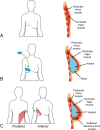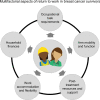The role of physical arm function and demographic disparities in breast cancer survivors' ability to return to work
- PMID: 36355217
- PMCID: PMC9648455
- DOI: 10.1007/s00520-022-07449-w
The role of physical arm function and demographic disparities in breast cancer survivors' ability to return to work
Abstract
Purpose: Ability to return to work (RTW) is an important aspect of breast cancer that is limited for many survivors. With 90% survivorship in the USA, it is imperative that focus shifts toward the improvement of physical arm function to improve survivors' ability to RTW. This narrative review discusses the role of physical arm function and demographic disparities in breast cancer survivor RTW.
Methods: Literature on physical function, arm function, and demographic disparities following breast cancer treatment and their implications for RTW is discussed.
Results: The ability to RTW is a key component of recovery for breast cancer survivors, but challenges and inequalities persist. Treatment effects can induce and prolong functional disability, affecting survivors' ability to RTW. These effects may be compounded for survivors whose occupation requires physical arm function. The RTW landscape, including the occupations survivors have, the physical function required for job tasks, and availability of workplace accommodations, is also unclear. Additional demographic disparities (e.g., income, live in rural area) exist, but the extent to which these factors influence RTW is not well understood. More work is needed to understand the compounded impact of treatment effects, demographic disparities, and occupational factors on RTW. Multidisciplinary rehabilitation that includes occupational counseling and exercise is a promising approach, but widespread adoption in the US healthcare model presents an ongoing challenge. Areas for further research are highlighted.
Conclusion: There is an incomplete understanding of the effects of treatment on physical arm function and the role of demographic disparities on breast cancer survivor RTW.
Keywords: Breast reconstruction; Cancer survivors; Mastectomy; Physical endurance; Return to work; Treatment outcome.
© 2022. The Author(s), under exclusive licence to Springer-Verlag GmbH Germany, part of Springer Nature.
Conflict of interest statement
The authors declare no competing interests.
Figures


Similar articles
-
A scoping review of return to work decision-making and experiences of breast cancer survivors in Korea.Support Care Cancer. 2021 Apr;29(4):1741-1751. doi: 10.1007/s00520-020-05817-y. Epub 2020 Oct 17. Support Care Cancer. 2021. PMID: 33070232
-
Physical exercise and return to work: cancer survivors' experiences.J Cancer Surviv. 2013 Jun;7(2):237-46. doi: 10.1007/s11764-012-0264-4. Epub 2013 Feb 27. J Cancer Surviv. 2013. PMID: 23443319
-
Development of a return-to-work planning tool for cancer survivors: Élaboration d'un outil de planification du retour au travail pour les survivants du cancer.Can J Occup Ther. 2017 Oct/Dec;84(4-5):223-228. doi: 10.1177/0008417417700916. Epub 2017 May 11. Can J Occup Ther. 2017. PMID: 28494611
-
Return to work after breast cancer: The role of treatment-related side effects and potential impact on quality of life.Eur J Cancer Care (Engl). 2019 Jul;28(4):e13051. doi: 10.1111/ecc.13051. Epub 2019 Apr 29. Eur J Cancer Care (Engl). 2019. PMID: 31033073 Clinical Trial.
-
Return to work after a cancer diagnosis: a meta-review of reviews and a meta-synthesis of recent qualitative studies.J Cancer Surviv. 2020 Apr;14(2):114-134. doi: 10.1007/s11764-019-00828-z. Epub 2019 Dec 19. J Cancer Surviv. 2020. PMID: 31858379 Review.
Cited by
-
Factors influencing psychological distress among breast cancer survivors using machine learning techniques.Sci Rep. 2024 Jul 1;14(1):15052. doi: 10.1038/s41598-024-65132-y. Sci Rep. 2024. PMID: 38956137 Free PMC article.
-
Prognostic factors for return to work in breast cancer survivors.Cochrane Database Syst Rev. 2025 May 7;5(5):CD015124. doi: 10.1002/14651858.CD015124.pub2. Cochrane Database Syst Rev. 2025. PMID: 40331515 Review.
References
-
- Society AC. 2021 [cited 2021 Feb 13]. Survival rates for breast cancer [Internet]. Available from: https://www.cancer.org/cancer/breast-cancer/understanding-a-breast-cance...
Publication types
MeSH terms
LinkOut - more resources
Full Text Sources
Medical

